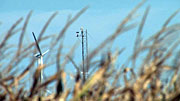- Number 328 |
- January 10, 2011
Wind turbines beneficial to crops

Wind turbines in Midwestern
farm fields.
Wind turbines in Midwestern farm fields may be doing more than churning out electricity. The giant turbine blades that generate renewable energy might also help corn and soybean crops stay cooler and dryer, help them fend off fungal infestations and improve their ability to extract growth-enhancing carbon dioxide [CO2] from the air and soil.
Speaking recently at the annual meeting of the American Geophysical Union in San Francisco, a researcher at DOE’s Ames Laboratory and his co-researcher from the University of Colorado announced the preliminary findings of a months-long research program aimed at studying how wind turbines on farmland interact with surrounding crops.
“We’ve finished the first phase of our research, and we’re confident that wind turbines do produce measureable effects on the microclimate near crops,” said Ames Laboratory associate and agricultural meteorology expert Gene Takle. According to Takle, who is also a professor of agricultural meteorology and director of the Climate Science Program at Iowa State University, the slow-moving turbine blades that have become a familiar sight along Midwestern highways, channel air downwards, in effect bathing the crops below via the increased airflow they create.
His colleague in the research is Julie Lundquist, assistant professor, Department of Atmospheric and Oceanic Sciences, at the University of Colorado at Boulder, joint appointee at the U.S. Department of Energy’s National Renewable Energy Laboratory, and Fellow of the Renewable and Sustainable Energy Institute. Lundquist’s team uses a specialized laser known as a LIDAR to measure winds and turbulence from near the Earth’s surface to well above the top tip of a turbine blade.
“Our laser instrument could detect a beautiful plume of increased turbulence that persisted even a quarter-mile downwind of a turbine,” Lundquist said.
Both Takle and Lundquist stressed that their early findings have yet to definitively establish whether or not wind turbines are in fact beneficial to the health and yield potential of soybeans and corn planted nearby. However, their finding that the turbines increase airflow over surrounding crops, suggests this is a realistic possibility.
“The turbulence resulting from wind turbines may speed up natural exchange processes between crop plants and the lower atmosphere,” Takle said.
For instance, crops warm up when the sun shines on them, and some of that heat is given off to the atmosphere. Extra air turbulence likely speeds up this heat exchange, so crops stay slightly cooler during hot days. On cold nights, turbulence stirs the lower atmosphere and keeps nighttime temperatures around the crops warmer, potentially warding off early fall frosts and extending the growing season.
Other benefits of wind turbines could result from their effects on crop moisture levels. Extra turbulence may help dry the dew that settles on plants beginning in late afternoon, minimizing the amount of time fungi and toxins can grow on plant leaves. Additionally, drier crops at harvest help farmers reduce the cost of artificially drying corn or soybeans.
Another potential benefit to crops is that increased airflows could enable corn and soybean plants to more readily extract atmospheric CO2, a needed “fuel” for crops. The extra turbulence might also pump extra CO2 from the soil. Both results could facilitate the crops’ ability to perform photosynthesis.
Submitted by DOE's Ames Laboratory
